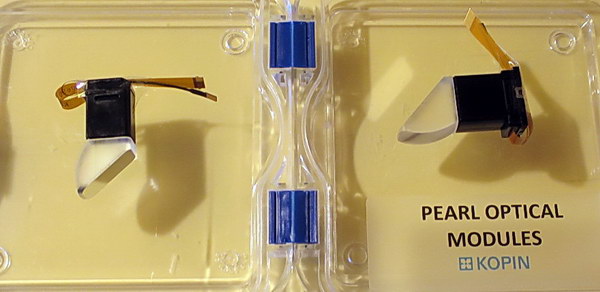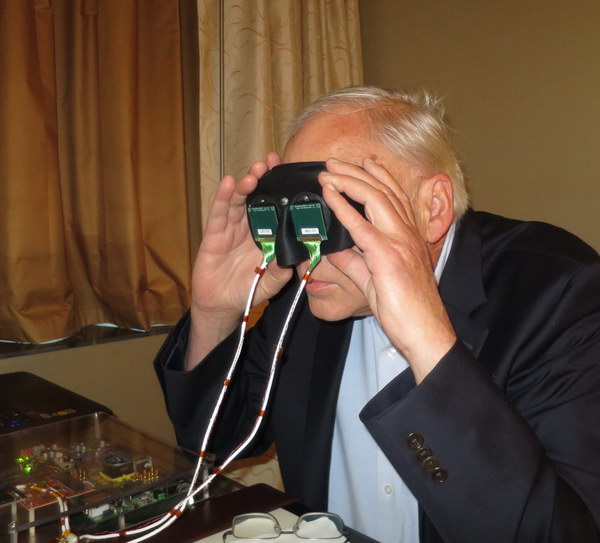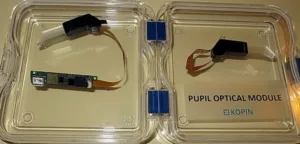Kopin Corporation was not an exhibitor at Display Week. Instead, it had a suite at the nearby Ritz-Carlton hotel. I had a chance to visit with Stuart Nixdorff on Tuesday morning at 7:00AM. It was a busy week for both of us and that was the time that seemed to work best.
First Nixdorff gave some background on Kopin. They provide three display technologies that are key to near eye displays (NEDs): transmissive LCD, OLED and LCoS. The transmissive LCD is based on their silicon transfer process so the transistors have higher performance than the normal transistors in transmissive LCD systems and the panel has a higher aperture ratio. The LCoS technology is based on the acquisition of the Scottish firm ForthDD several years ago. The OLED technology was the focus of what I saw at Display Week. Both the LCD and OLED technologies were developed in-house. For OLED manufacturing, Kopin has partnered with BOE and Goertek. (IC03 Kopin Has a Real Business in AR/VR) All the LCD panels are transmissive with color filters and all the Kopin OLED microdisplays are color-by-white.
Only the LCoS technology was acquired. ForthDD largely operates as an independent company and maintains its own website and product portfolio. When used in an imaging application, ForthDD LCoS is generally used in color sequential mode.
In addition to their display business, Nixdorff told me Kopin has a significant amount of system business, especially with the military and similar applications. He told me about a firefighter’s helmet with an IR imager that can see through smoke and a NED that allows the firefighter to see what is around him, things that normally would be hidden by the smoke. Then business is primarily in the form of optical modules that include a Kopin-made display. At SID, Nixdorff showed me two of the current optical modules form Kopin, the Pupil and Pearl modules.
Pupil optical module from Kopin. (Credit: M. Brennesholtz)
The Pupil optical module is named because the output end of the modules is 4mm in size, smaller than the typical diameter of the human pupil. Therefore, the eye can both see the AR output of the module and the real world behind it. I tried it and, surprisingly, it does work fairly well and the module doesn’t really block much of the view of the outside world. One of the advantages of the Pupil design is its high efficiency, about 70% compared to about 20% for a conventional see-through HMD. The Pupil module is made under license from Olympus Corporation, original developer of the module. Solos Wearables makes NEDs for bike riders using the Pupil module. Solos provides both iOS and Android apps for its NED. Besides the normal map, navigation and speed functions, the Solos app provides a group chat function for a group of bike riders.
 Pearl optical modules from Kopin (Credit: M. Brennesholtz)
Pearl optical modules from Kopin (Credit: M. Brennesholtz)
The Pearl module is designed to use the WQVGA (428 x 240) LCD from Kopin with a 0.20″diagonal. The LCD, backlight and the optics are delivered in a compact (28.3 x 12.9 x 8 mm) package. The Pearl is also available with Kopin’s NHD (640 x 360) LCD microdisplay.
 Kopin 2k x 2k OLED microdisplay in a demonstration HMD (Credit: M. Brennesholtz)
Kopin 2k x 2k OLED microdisplay in a demonstration HMD (Credit: M. Brennesholtz)
Kopin is in the process of developing optical modules for its 2k x 2k OLED display and I got to try one, as shown in the image. Nixdorff told me the displays in the prototype HMD operate at 120Hz and the optics were designed to provide images with 32 pixels per degree, which is much closer to the limit of human visual acuity than the normal VR HMD. The image it provided was, in fact, very good. Unfortunately, I suspect few outside the military can afford a HMD with two 2k x 2k OLED microdisplays in it. –Matthew Brennesholtz

